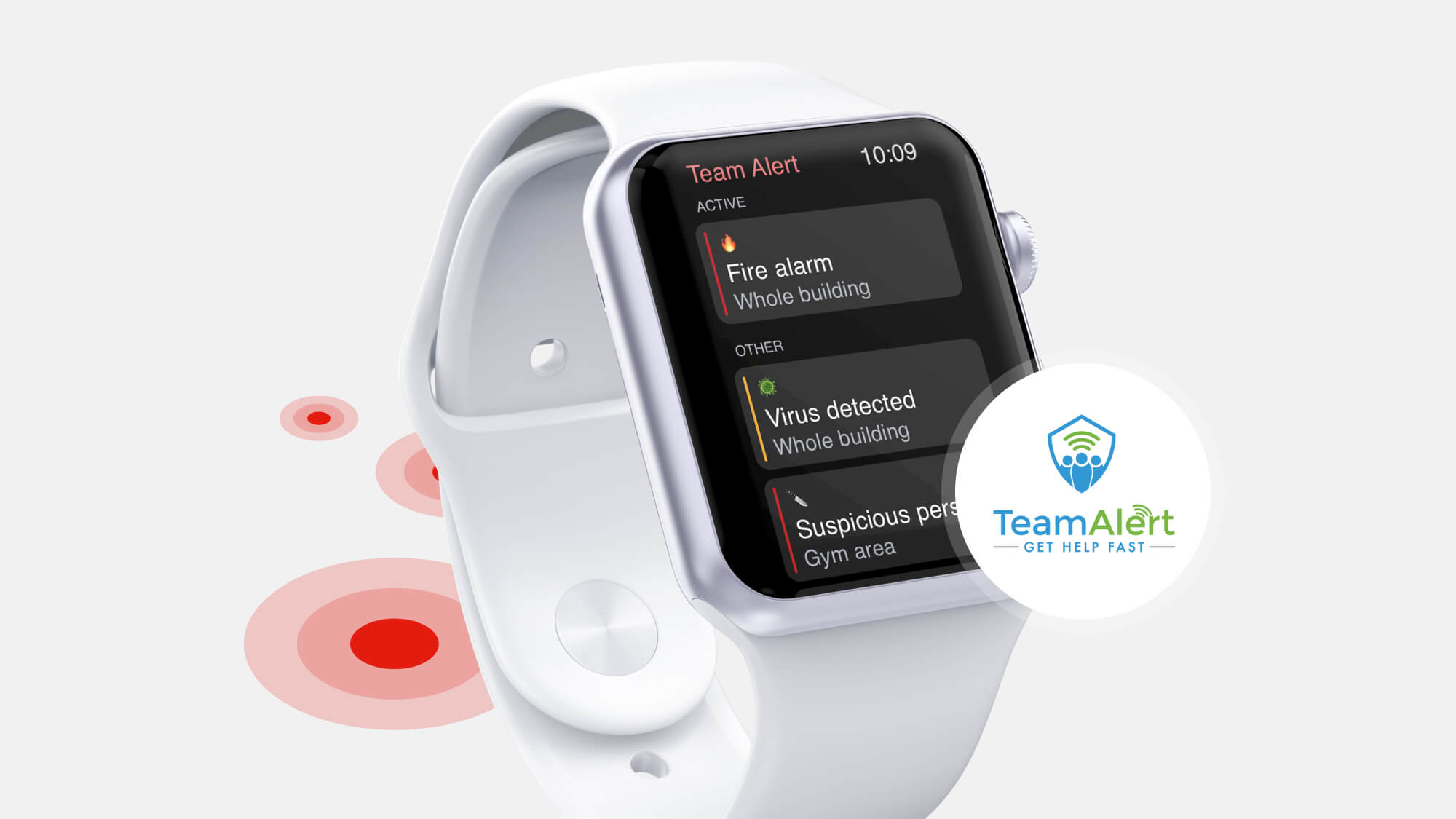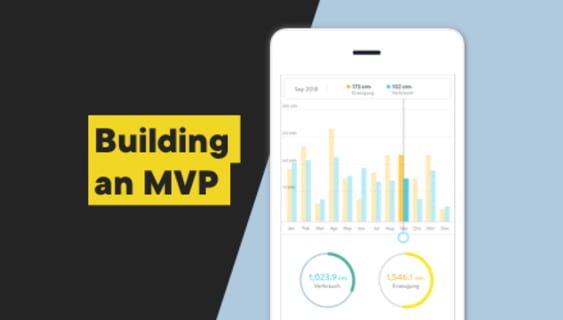How we helped TeamAlert transition from MVP to Product-Market Fit
Through years of experience in building digital products, we’ve discovered that it’s not only important to lead the product through a full cycle of product development, but also to support the process of transition between individual phases. Here is an example of how we helped a US company - TeamAlert - with the transition of their digital app from the MVP stage to the product-market fit phase. The process resulted in a 300% increase in the number of users and over 40 new features. Read about our approach, steps taken, and client outcomes.

Table of contents
About the client - TeamAlert
Our client - TeamAlert, is a US company providing alert systems for private companies and public institutions. Their core product is a workplace panic button app available for web and mobile devices, but also in a physical form. TeamAlert serves clients across six different countries and 48 states of the US. Their products enable workers to easily call for assistance in case of emergency, or alert co-workers, the police, or private security about dangerous events.

We started working with TeamAlert in 2019. They approached us when they needed to implement major changes in their existing panic button system (version 1.0). The first round of our cooperation was all about creating an MVP (version 2.0 of the product) and testing new product hypotheses with minimal budget and resources. The TeamAlert crew needed a secure product, fully cloud-based, and developed in-line with all tech standards.
Eventually, we built and tested three different products together, expanding the client’s offer to new groups of customers. Within 500 hours (spread across approx. three months), we developed three mini-projects:
- an Apple Watch application,
- a physical panic button (hardware),
- an app connectable via Bluetooth.

After an MVP was ready and released, the TeamAlert crew decided to move towards the most important of all full cycle product development phases: product-market fit. At this stage, they had already noticed some blockers and identified areas where they would need Boldare’s consultancy. We will look at some of these in a moment. For now, let’s clarify the meaning of the PMF phase.
What is the Product-Market Fit phase?
The Product-market fit phase (PMF) is a key phase in the digital product creation cycle. It determines the future profits from product sales and actual ROI value. For moving a product into that phase you need to know your target groups and the exact pain points of each user type. In the PMF phase, specialized teams investigate the market to estimate the number of actual and potential prospects, total addressable market, competitors, buyers’ preferences, potential income, etc. But for all this to happen, real understanding of the product and business model is required. You need to know what new features to implement in order to address the actual needs of your specifically targeted audience, and where (and how!) to sell your product for maximum business benefits.
Minimum Viable Product vs. Product-Market Fit
An MVP tries to answer the question: is there a need for this product on the market? PMF on the other hand, looks much deeper into the business model, communication channels, marketing, and sales strategy. It validates not the product itself, but the whole business model. It aims to increase the product’s overall chances of a successful and profitable future.
The problem
TeamAlert stakeholders had basic knowledge of their target user groups, gathered from user feedback, but they needed wider market orientation and a deeper understanding of their user and buyer personas. They had a wide range of industries they could sell their product to - from the medical sector, through education, worship, government, to private and business security - but they were not sure where it was worth investing their future efforts and which segment to focus on in order to reach their business goals.
To move with their product towards PMF, the TeamAlert owners needed to specify their choice of targeted segments. For this, they had to gain a broader perspective and a clear vision of their next steps in further developing existing TeamAlert products. This is how their CEO, Allan Wilson, describes it:

Once we had about two dozen customers, they started telling us what features they really wanted us to implement into our product. But… the customers were random and came from different market sectors. They were not representing any specific industry. Moreover, some of them were paying for the app, and some used a free version of it. So, before we came to Boldare, we had only been guessing at the particular needs of our specific user groups
After discussing the clients’ needs we figured out the common priorities and solutions serving TeamAlert stakeholders, their digital product, and - of course - final users. Keep on reading to find out about our methods of guiding TeamAlert through the transition to the product-market fit stage.
The solution
For solving client issues, we offered a series of consulting services, such as consultancy meetings and insightful business-oriented workshops, digging deeper into product value, target personas, and customer segmentation. We decided to use the business model canvas (BMC) - a simple and smart tool for creating detailed business models and marketing strategies. The business model canvas is a table with nine separate cells, which we needed to fill with specific data about:
- key partners,
- key activities,
- key resources,
- value propositions,
- customer relationships,
- communication channels,
- customer segments,
- cost structure,
- revenue streams.
In order to implement this solution, some preparation was necessary. Boldare organized a number of meetings with TeamAlert to get on the same page in terms of understanding the product-market fit phase - especially the business and product goals. This highlighted a few key areas that needed further exploration. These were: customer segmentation, target persona and product value proposition. With these outcomes we were ready to start the process.

The process
The first workshop took place in May 2021 and aimed to analyze TeamAlert’s business model. The Boldare team worked together with TeamAlert’s experts: Allan Wilson (CEO), Joe Propheta (VP of Sales), and Laura Lynn Ray (Success Guide). On our side, we engaged Aneta Orszewska (Product Strategist), and Claudia Wensierska (Senior Product Designer). The main goal of the whole series of workshops was to match the customer segment with a unique value proposition. The whole process consisted of the following actions:
- Carefully choosing target segmentation.
- Describing user and buyer personas in detail.
- Creating unique value propositions for particular personas from chosen segments.
- Setting hypotheses for various personas from various segments.
- Validating hypotheses by conducting in-depth interviews.
- Analyzing outcomes.
- Verifying the whole process.
- Drawing a roadmap with further steps.
Segmentation, target personas, and value proposition
At the first workshop, we concentrated on customer segmentation. For the product to survive in the market it is fundamental to understand the trade-off between different customer segments and select the right ones for targeting. After this very first workshop, Allan Wilson (TeamAlert’s CEO) wrote to us:
This is already beyond my expectations. I can see now that we were moving without any direction, just serving all customers who came to us. We can achieve much more with this clear, focused approach. We will find our niche with Boldare.
But that was only the beginning of our adventure. We then moved to describing user and buyer personas from the chosen customer segments. Here we used simple tables as templates for analyzing business target personas from the different segments. In the next step, we dug deeper into those personas’ pains and gains, and we compared our insights with the products’ values and benefits. This comparison was possible because we applied an effective analytical tool called the value proposition canvas. And what was the outcome?
- The TeamAlert crew understood how to address the particular needs and desires of their targeted customer groups.
- They had knowledge of the distribution channels that they should choose for each of the groups.
- They had an idea what kind of relationship TeamAlert should build with customers from each of the segments.
- They knew which product features and values are crucial for particular groups of customers.
Setting and validating hypotheses
With set descriptions of target customers, we were able to develop our hypotheses regarding their concerns and needs. We did it using hypothesis testing cards that contain four fields to be filled with specific information. The fields are:
- hypothesis - We believe that…
- action - To verify that, we will…
- data collection - And measure…
- validation - We are right if…
Boldare’s team helped the TeamAlert crew in preparing questions and online surveys for in-depth interviews with their potential customers. The next step was to conduct the interviews, which happened at the end of 2021. Some of the hypotheses were validated positively and some ended up with a negative validation - in both cases the outcome was valuable for our client.
Future plans
At the time of writing this article, TeamAlert have managed to gather very insightful feedback from a group of over 10 target personas from chosen market sectors. We have also started to analyze the outcomes and slowly transition into summarizing the whole process. Nevertheless, there are concrete plans and recommendations for future steps that we would like to take together with TeamAlert.
In the area of business and sales, we plan on:
- analyzing user insights vs the hypotheses list,
- checking what has been validated,
- determining what we need to change in the value propositions per segment (via workshop sessions).
Here the goal is to know which segment is crucial and what features must be added to the product to fulfill customer needs in this segment, and - by doing so - to increase sales.
In the area of the product, we are planning:
- user insights analysis and prioritization,
- roadmap creation - drawing directions for the product growth per segment; listing new features per segment (a workshop with a map of priorities),
- to create a high-level backlog for further product development.
In the field of product design and user research, we are planning:
- prototyping and mockups,
- improving the UI,
- validating new UI proposals with users,
- developing TeamAlert 3.0.
Final outcomes and learnings
Before Boldare’s intervention, the TeamAlert sales team had no specified target group and no knowledge of how they could use the market to improve sales. They were selling their products to random customers, so they struggled to find an intentional and structured approach to move their product towards the product-market fit phase. With Boldare, they discovered new, customized ways of marketing TeamAlert systems to business segments with high sales potential.

Here is what Allan Wilson said about TeamAlert’s overall experience with Boldare:
I knew that you guys were good at software development and I knew you could help us create a good product, but in the end, I saw that you really understood software development (…), you’ve seen all the phases, (…) you provide much more than just product development, or just code writing. (…) Everybody says they can help us, but you guys actually do it and that’s a significant difference.
Judging by our client’s feedback, we believe we transferred a significant amount of knowledge to TeamAlert stakeholders. We educated them in the area of full cycle product development, development phases, business models, Agile tools and approach, target segments and personas, and much more. We hope this knowledge will serve them for the best and will quickly help them to jump to a stage of the perfect product-market fit.
Share this article:






